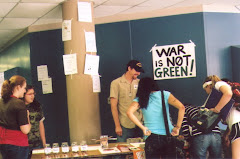Today was our first day back at SOY tabling for the new semester. We had a great visit at Austin High School! Students were very engaged and seemed eager to check out the table, answering the t-shirt challenge questions. They offered very thoughtful responses to the questions that asked their own opinions, and we were impressed with their quick ability to research information, too. Thanks, Maroons!
Most of the t-shirts we used today were hand-screened by Malachi over the summer, using this image, created by Juanita:
Several school teachers and staff stopped by the table, too, to offer encouragement. Susana had tweeted on the school site that we would be there today, which was a great idea.
We happened to be tabling today right across from a table of army recruiters -- that was a first for us at that school. We welcomed the opportunity for students to compare and contrast between the army materials and ours. One important concern, though: the recruiters were soliciting contact information from students who were younger than 18, which they really should not be doing if they don't know whether a student's parent or guardian has requested on the SR290 form that their child's contact information not be given out to recruiters. This is a loophole we are seeking to close through the school administration.

Here are some of the items on the army recruiters' table. Do all recruits receive $54,000 in education benefits? No. It means 8 years of enlistment and meeting certain requirements along the way. Also, most veterans wind up making use of only a fraction of their GI Bill benefits because of a variety of reasons: family responsibilities, health concerns, lack of time because of work, etc. Students who are thinking of enlisting because of the education benefits must do their research to find out if all the promises made by the military are kept -- and should ask themselves if what they are exchanging for those benefits -- 8 years or more of their lives -- is worth it.



















